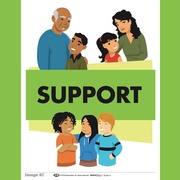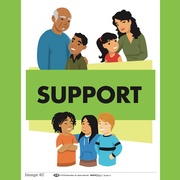Understanding the HealthSmart Approach to Health Education - Part 1
By Suzanne Schrag | October 30, 2017
Editor/Product Manager, ETR
I’ve been working with HealthSmart, ETR’s comprehensive, K-12 health education program, since its inception.
We’ve recently been traveling to different states to introduce schools, districts and DOEs to the HealthSmart program. Often we are presenting HealthSmart alongside more traditional textbook publishers.
HealthSmart is not a textbook program. In fact, it’s quite different from a textbook approach to health class. We’ve given a lot of thought to how we explain what may be a new way to think about health instruction for administrators and educators.
In Part 2 of this series, we examine the theoretical foundation of HealthSmart, and the ways it puts what research tells us about effective programs into action. In Part 3, we look at the ways HealthSmart builds competence and self-efficacy by addressing skills—thereby achieving Healthy Behavior Outcomes.
What Makes Health Different?

The topic of health education is distinct from other subjects students study at school. Perhaps the most immediate difference is that health is not just about information you can cover in a textbook. It’s something kids are living every day. We see it in:
- The choices they make. Do they choose an apple or chips for a snack? Quench their thirst with water or an energy drink? Choose to play basketball with friends after school or head indoors to play video games?
- How they communicate. How do they talk to and relate with their friends, family, classmates and teachers? How do they express their feelings? How do they handle a disagreement or resist pressure from others?
- The ways they are influenced by the people and things around them. The norms students see—and, sometimes even more important, the norms they think they see (the perceived norms)—can either support or discourage healthy behaviors.
- Their attitudes and beliefs. What students’ think, feel and believe can have a significant impact on their choices and behaviors around health.
HealthSmart lessons are designed to impart key health concepts—the knowledge—and provide practice in the skills—the practical applications—that will help children and teens think, choose and act in healthy ways.
What Makes HealthSmart Different from a Textbook Program? Healthy Behavior Outcomes!
Most textbooks provide information about a range of topics related to health, especially topics that have proven popular in school settings. The biggest difference between the HealthSmart program and a more traditional health textbook is that the primary goal of HealthSmart is to use science-informed approaches to impact students’ health behaviors in a positive way.
Research on what makes a health education program effective is ongoing. But there are a number of qualities or characteristics that research has found in programs that work. Incorporating these best practices has been key to the development of the second edition of HealthSmart, and the program meets the 15 Characteristics of Effective Health Education Curricula defined by the CDC.
The very first characteristic on the CDC list is that an effective program “focuses on clear health goals and related behavioral outcomes.” That is the top priority for HealthSmart as well!
HECAT: Concepts and Skills Students Need to Know
About 5 years ago, the CDC completed the latest revision of their Health Education Curriculum Analysis Tool or HECAT. CDC’s panel of health experts focused on nine main health content areas, and identified the important healthy behaviors within each of these areas. These are the behaviors they want to see adolescents practicing by the time they graduate from high school. The panel determined what concepts students would need to know (Knowledge Expectations) and what skills they would need to be able to practice (Skill Expectations) in order to achieve these Healthy Behavior Outcomes.
The HECAT is intended as a tool to help schools analyze health curricula to see if they align with these Key Knowledge and Skill Expectations, which, in turn, align with the National Health Education Standards. The thinking is that when a curriculum meets these Knowledge and Skill Expectations, it will impact student behavior in a positive way.
The Healthy Behavior Outcomes defined in the HECAT—the things students should be able to do by the time they graduate in order to be health literate—drive the instruction and lesson objectives in HealthSmart for all grades, K through 12.
ETR is in the fortunate position of having health education expert Dr. Susan Telljohann as the lead developer of HealthSmart. Dr. Telljohann was on the committee that designed both the original HECAT and the CDC’s latest revision. Her deep understanding of both the HECAT and the 15 Characteristics have given HealthSmart excellent alignment with what the CDC and health experts across the nation consider essential knowledge and skills for practicing healthy behaviors.
More than any other feature, this primary focus on the ultimate goal of helping young people achieve key Healthy Behavior Outcomes makes the HealthSmart program unique. Everything in this comprehensive K through 12 program is geared to giving young people the knowledge and skills they need to practice healthy behaviors and attain lifelong health.
In Parts 2 and 3 of this post, I’ll discuss the ways HealthSmart puts health education research into action, and how the program actually teaches key concepts and skills.
Check It Out
If you’re intrigued by the HealthSmart approach and would like to learn more about this comprehensive, research-based, standards-aligned K–12 health education program, visit the HealthSmart website. You can also email or call ETR at 1-888-220-9455 to set up review access to the digital edition of the program.
Suzanne Schrag is an Editor and Product Manager at ETR. She is the HealthSmart series editor and one of the authors of the new second edition of HealthSmart K–5. She can be reached at schs@etr.org.





